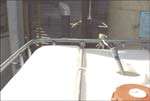Chemical Switch Cuts Costs, Improves Safety
By replacing the sodium sulfide chemistry used in its nitrogen oxide (NOx) scrubber with a non-hazardous NOx control chemistry, ChemResearch Co. Inc. (CRC; Phoenix, AZ) reduced its operating costs and eliminated a health and safety hazard.
#medical #regulation
The BIONOxSOLVER™ chemistry, developed by Bionomic Industries Inc. (Mahwah, NJ), provides CRC with a safe, easy-to-handle, high-efficiency NOx scrubbing solution that eliminates the production of toxic and odoriferous hydrogen sulfide gas.
Since 1998, CRC had used sodium sulfide chemistry in the NOx scrubber at the end of its dedicated aluminum precleaning process. Used to prepare a cast aluminum cylinder for a small engine for hard chromium plating, the automated line cleans and etches the parts using various cleaner and acid baths. The acid baths contain nitric/water or straight nitric/hydrofluoric mixtures. Each load of parts has about 450 sq ft of surface area, with one load processed every seven to eight minutes, sometimes around the clock. When the parts come out of the acid baths, a large volume of NOx is released.
Featured Content
Captured by a ventilation system, the acid fumes are taken to a dedicated 10,000-cfm vertical packed-bed NOx scrubber. “A number of factors led us to begin looking for a less labor intensive and less hazardous alternative to the sodium sulfide chemistry,” explains CRC Director of Regulatory Affairs and Facility Development David Weed. “Making up that sodium sulfide tank was time-consuming and generated potentially hazardous vapors. Since the chemistry was potentially subject to annual regulatory reporting requirements, we were required to perform and maintain time-consuming record keeping.”
According to Weed, sodium sulfide use, coupled with sodium hydroxide, generates scale buildup on the scrubber tank and packing, making cleaning and maintaining the system labor-intensive. The scrubber also required an annual cleaning, which took approximately 28 man-hours, as well as the purchase and disposal of five drums of hydrochloric acid.
CRC was also concerned about the safety of the tank itself. It was inside another lined tank, vented with an exhaust duct into the scrubber to prevent release of fumes into the atmosphere and in a secure fenced area surrounded by a containment curb. But a heavily used railroad track was just feet away and a derailment could pose an extreme hazard.
Weed learned that BIONOxSOLVER could potentially alleviate all these concerns, and decided to try a trial conversion. Because the product is delivered in ready-to-use totes, CRC personnel don’t handle it. Instead, a worker moves a tote into place and inserts a pickup tube from a metering pump. “With the sodium sulfide chemistry, we had to fill the tank with water and use a mixer motor to dissolve the sodium sulfide flake,” Weed recalls. “This was a very undesirable task, especially during the summer here in Phoenix.”
As a result of the chemical switch, CRC has reduced its labor costs by about 75% by eliminating many of the procedures the former chemistry required. The scrubber is easier to maintain and there is little to no scale buildup. Annual cleaning, required with the sodium sulfide chemistry, has been eliminated.
The company gained additional savings by eliminating protective gloves, aprons, respirators and cartridges required for handling sodium sulfide. Because the new chemistry does not require the 19,000 gallons of water and the electricity for the mixer motor that the sodium sulfide solution needed annually, CRC is saving another $450. The pH operating range was also reduced from prior levels, cutting the amount of caustic used and purchased.
“Converting to the new chemistry was completed in a weekend,” Weed says. “As a result of the conversion’s ability to help us reduce an on site hazardous material, we accomplished a pollution prevention goal that we set with our state EPA office.” The new chemistry also virtually eliminated health and safety risks to employees, he added.
RELATED CONTENT
-
Advanced Solvent Technology for Medical Device Cleaning
An insider's look at new critical cleaning technologies being used in the manufacture of medical instruments.
-
Nickel Exposures in the Plating Workplace and Environment
Regulators are scrutinizing nickel and other metals because of real and alleged effects on the environment and human health...
-
Managing Stacked Tolerances with PTFE Lubricants
PTFE coatings allow surgical instruments to overcome static friction.





















